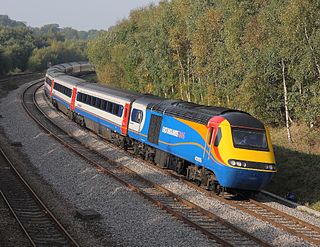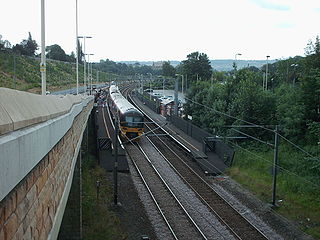The Yorkshire and Humber Route Utilisation Strategy is a Route Utilisation Strategy (RUS), published by Network Rail in July 2009; [1] it was the twelfth RUS to be completed, not counting the partially completed Network RUS.
Network Rail (NR) has an obligation, transferred from the abolished Strategic Rail Authority, to periodically produce Route Utilisation Strategy (RUS) documents. The original programme was approved by the Office of Rail Regulation (ORR) in June 2006; under an early version of the programme all but two RUSs were scheduled to be completed by the end of Control Period 3 (CP3), 31 March 2009. The programme and its timescale were reviewed by NR and ORR at regular intervals. Despite this the delivery timescales continually slipped: at the end of CP3 no fewer than 9 remained incomplete, despite the fact that funding for infrastructure developments in CP4 was largely set.

Network Rail is the owner and infrastructure manager of most of the railway network in Great Britain. Network Rail is an arm's length public body of the Department for Transport with no shareholders, which reinvests its income in the railways.
Contents
By default, RUSs are established by the Office of Rail Regulation (ORR) unless the latter objects within 60 days. The RUS is included in NR's map as established. [2]
The scope corresponds roughly with Strategic Routes 10 (North Cross-Pennine, North and West Yorkshire [3] ) and 11 (South Cross-Pennine, South Yorkshire and Lincolnshire [4] ).
The Y&H RUS picked up several issues from other RUSs, specifically:
- Freight RUS, throughout the RUS area
- North West RUS, mainly as regards the Calder Valley, Hope Valley and Huddersfield corridors
- East Coast Main Line RUS, mainly at Wakefield Westgate, Doncaster, Leeds and York
- Lancashire and Cumbria RUS, mainly as regards the Airedale and Calder Valley corridors
- the Network RUS, Electrification workstream
- the former Strategic Rail Authority’s Midland Main Line RUS.
The North West Route Utilisation Strategy (NWRUS) is a Route Utilisation Strategy, published by Network Rail in May 2007. It was the fifth RUS to be produced. It was included in a map published by the Office of Rail Regulation as established in May 2007. It was the first of no fewer than 5 RUSs which cover specific routes in the north-west of England; the others are the Lancashire & Cumbria RUS, the Yorkshire & Humber RUS, the Merseyside RUS, and the West Coast Main Line RUS. In particular it "broadly covers the Manchester journey to work area, the City lines into Liverpool Lime Street and routes from Manchester to Kirkby, Southport and Blackpool", corresponding to Network Rail's then Route 20 - North West Urban.
The East Coast Main Line Route Utilisation Strategy (RUS), published by Network Rail in February 2008, was the seventh RUS.
The Lancashire and Cumbria Route Utilisation Strategy is a Route Utilisation Strategy, published by Network Rail on 29 August 2008 It was the ninth RUS to be produced.
Issues in the Y&H RUS were also relevant to the East Midlands RUS (in draft as at early November), mainly at Chesterfield and in Lincolnshire.
As with other RUSs, the Y&H RUS took into account a number of responses, [5] [6] [7] including the Office of Rail Regulation (ORR) . [8]
The routes and services covered by the RUS are varied in type. Many lines are used for passenger services with very little, if any, freight; some lines on the other hand are largely for freight. A number of passenger transport executives (PTEs) have significant influence over transport planning in the area.
In the United Kingdom, passenger transport executives (PTEs) are local government bodies which are responsible for public transport within large urban areas. They are accountable to bodies called integrated transport authorities (ITAs), or where they have been formed, to combined authorities. The PTEs joined together to form the Passenger Transport Executive Group (PTEG) of which Strathclyde Partnership for Transport and Transport for London were both associate members. In 2016 it became the Urban Transport Group.
Some issues were passed to the Network RUS, Electrification workstream.
The RUS needs to be seen against existing contingent and prospective schemes, particularly in Control Period 4.






